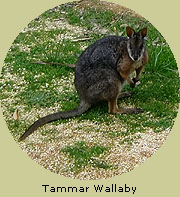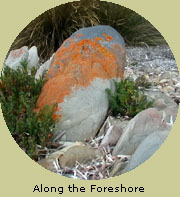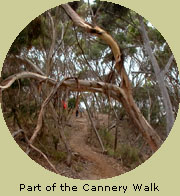|
35°79' S, 137°75' E
American River
is a small town tucked into native bush overlooking Eastern Cove
and Pelican Lagoon. The hustle and bustle and the crowds that
you may be used to are missing but at night the town comes alive
with wallabies and possums.
In the daytime
the birdlife is prolific and in season many species of wildflowers
can be seen. Sheltered coastal waters offer wonderful opportunities
for fishing and nearby deserted beaches, great walking and swimming.
The town offers
a wide range of quality accommodation from camping through to
units, cottages and deluxe motel rooms. Excellent restaurants
serve both a la carte and counter meals. Takeaway meals are also
available. American River also offers fishing cruises, dinghy
hire, boat launching, scenic tours and shopping, making it the
ideal, central location for those seeking peace and quiet amongst
nature.
Matthew Flinders
visited the area in 1802 and named many features including Prospect
Hill, Pelican Lagoon, Eastern Cove and Kangaroo Head where his
crew were able to obtain their first supplies of fresh meat in
months. Sealers and whalers arrived within months of this first
visit, many of whom were escaped convicts, runaways etc. They
used the island as a base for trading skins and salt. Piracy was
common.
American River
gained its name from American sealers, some of whom built a trading
schooner (from native timber) in 1804 at Independence Point on
Pelican Lagoon. This was the beginning of the area's shipbuilding
history which was continued on by John Buick and Frank Potts in
1842. They were also the first to have farmed the area and their
descendants still reside in the district.
The sealing trade
brought a need for salt for preserving skins. The salt lakes in
the area provided the best available salt and an industry which
employed hundreds, resulting in a settlement, port and the Island's
only railway at Muston on Pelican Lagoon. Gypsum from these lakes
was exported from Ballast Head until 1992.
In the 1860's
rabbits were introduced to the area. Luckily they did not survive
and it is thought that goannas ate the young.
The tourist industry
on the Island has its roots at American River. Nils Ryberg set
up a guesthouse in the late 1890's. Also established in the late
1890's was a fish canning factory, situated north of American
River along the Scenic Walk.
Excellent fishing
has always been available at American River. Catches of over 70
dozen whiting in a day have been recorded. A local vessel the
'Stella' was the first vessel in South Australia to use craypots
and so the birth of the cray fishing industry in South Australia
began at American River in 1899. Gold and guano mining, timber
exporting, yacca gum collecting and eucalyptus oil distilling
were other industries carried out in the area.
The Sealers, Saltscratchers
and Shipbuilders Heritage Trail is a series of five interpretive
signs located at the wharf, adjacent CFS Shed, Scenic Walkway,
Muston Hill Lookout and Old Muston Jetty; relating some of the
early history of 'The River.'
A pleasant afternoon
or morning can be spent ambling along the 'Scenic Walk.' The track
begins at the northern end of the town and is clearly marked.
It is approximately a one and a half hour walk to the site of
the old fish canning factory. (Ruins are still visible.) For those
more adventurous it is possible to continue walking to Ballast
Head.
Birdlife is prolific
along the 'Walk.' Swans and Pelicans can be sighted offshore,
while Robins and Blue Wrens inhabit the scrub area above the water
line. Penguins live in the rocks near Ballast Head and an Osprey
nests each year at Ballast Head. A pair of Wedge-tailed Eagles
can often be seen soaring above the gully close to the old fish
cannery. A flock of rare Glossy (Red-tailed) Black Cockatoos feed
in American River and have a flight path from Ballast Head to
the township. They feast on the Casuarina trees, prolific in the
area and along the 'Scenic Walk.' There are many other birds including
Galahs, Parrots, Finches, Ibis, Spoonbills, Cormorants, Herons,
Oyster Catchers, Gulls and Sea Eagles both in the township and
along the 'Walk.'
 From
July onwards the wildflowers, including Orchids, begin flowering
along the 'Scenic Walk.' (Please remember it is against the law
to pick any wildflowers.) Many species are seen in the township
itself and the Freesia with its delightful scent abounds from
late July. From
July onwards the wildflowers, including Orchids, begin flowering
along the 'Scenic Walk.' (Please remember it is against the law
to pick any wildflowers.) Many species are seen in the township
itself and the Freesia with its delightful scent abounds from
late July.
For the less adventurous
it is well worth walking the length of the township's coast. Ducks,
Swans and Pelicans abound and inquisitive Pelicans will often
fly across to investigate what you are doing.
The wharf and
boat ramp areas are pleasant places to stroll. Here you can watch
the fishermen (amateur) bring in their catches, read the heritage
sign or chat with the hopefuls as they fish from the wharf. Then
continue to meander throughout the Remembrance Reserve.
There are few
towns in Australia that can boast Wallabies on their roads. Wait
until after dark and take a quiet stroll past the American River
Hall and Post Office. Wallabies abound in this area, especially
in summer when feed is scarce in the surrounding paddocks. (Remember
they come down to this area by choice and do not need hand feeding.)
|